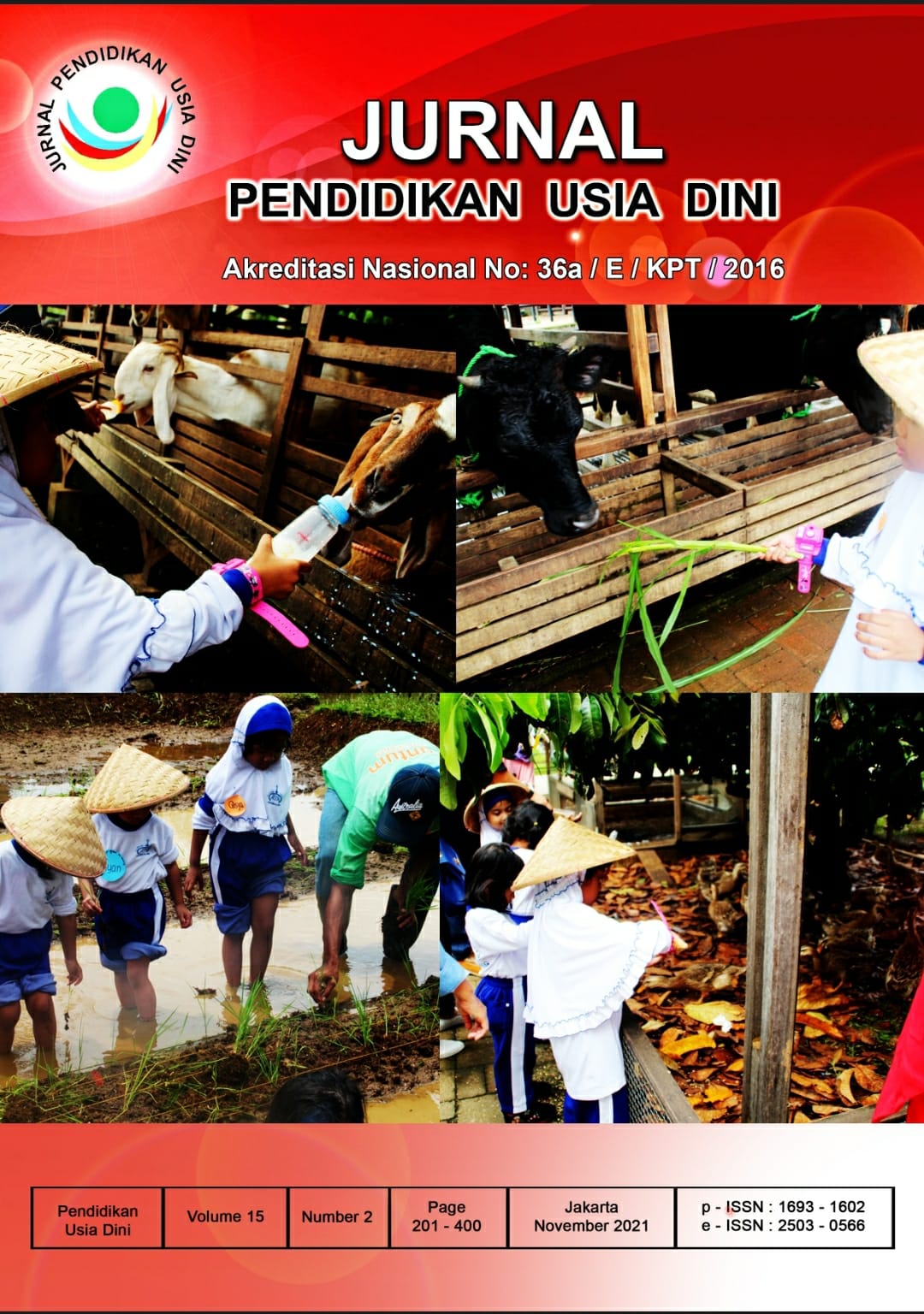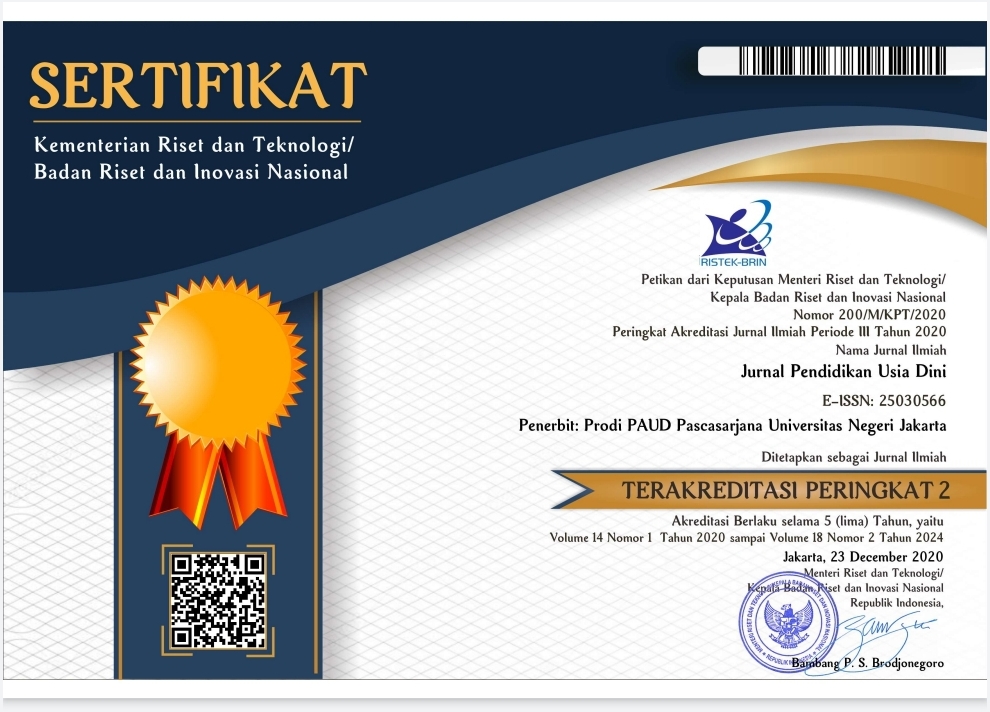Moving to The Beats: The Effect of Dance Education on Early Self-Regulation
DOI:
https://doi.org/10.21009/JPUD.152.11Abstract
Self-regulation in children is an important thing that needs to be prepared from an early age. Besides affecting children's school readiness, this also makes it easier for children to have good academic achievements. This study aims to determine the influence of moving to the beat of early childhood self-regulation. This research was conducted on kindergarten group B students in East Jakarta. The research method used is a quasi-experiment method with a sample of 20 students. The data collection technique uses observations by analysing paired t-test statistical data. The results of the study explained that there was a significant effect of moving to the beat of early childhood self-regulation. The significance level is 0.000 < 0.05, which means that H0 is rejected and H1 is accepted, this indicates a significant difference between the pre-test and post-test. For further research, it is recommended to look at the influence of other factors on early childhood self-regulation.
Keywords: Beats, Early childhood, Moving, Self-Regulation
References:
Baltazar, M., Västfjäll, D., Asutay, E., Koppel, L., & Saarikallio, S. (2019). Is it me or the music? Stress reduction and the role of regulation strategies and music. Music & Science, 2, 205920431984416. https://doi.org/10.1177/2059204319844161
Blair, C., & Raver, C. C. (2012). Individual development and evolution: Experiential canalization of self-regulation. Developmental Psychology, 48(3), 647–657. https://doi.org/10.1037/a0026472
Blair, C., & Raver, C. C. (2015). School Readiness and Psychobiological Approach. August 2014, 1–21. https://doi.org/10.1146/annurev-psych-010814-015221
Blair, C., & Razza, R. P. (2007). Relating Effortful Control, Executive Function, and False Belief Understand... Child Development, 78(2), 647–663. https://doi.org/10.2307/4139250
Booth, A., O’Farrelly, C., Hennessy, E., & Doyle, O. (2019). ‘Be good, know the rules’: Children’s perspectives on starting school and self-regulation. Childhood, 26(4), 509–524. https://doi.org/10.1177/0907568219840397
Cadima, J., Verschueren, K., Leal, T., & Guedes, C. (2016). Classroom Interactions, Dyadic Teacher–Child Relationships, and Self–Regulation in Socially Disadvantaged Young Children. Journal of Abnormal Child Psychology, 44(1), 7–17. https://doi.org/10.1007/s10802-015-0060-5
Charissi, V., & Rinta, T. (2014). Children’s musical and social behaviours in the context of music-making activities supported by digital tools: examples from a pilot study in the UK. Journal of Music, Technology and Education, 7(1), XXXXX. https://doi.org/10.1386/jmte.7.1.39_1
Dalla Bella, S., Berkowska, M., & Sowiński, J. (2015). Moving to the Beat and Singing are Linked in Humans. Frontiers in Human Neuroscience, 9(December), 1–13. https://doi.org/10.3389/fnhum.2015.00663
Danielsen, A., Haugen, M. R., & Jensenius, A. R. (2015). Moving to the Beat: Studying Entrainment to Micro-Rhythmic Changes in Pulse by Motion Capture. 0315.
Diamond, A. (2013). Functions, Executive. Annual Reviews Psychology, 29(146), 13–15. https://doi.org/10.1146/annurev-psych-113011-143750
Diamond, A. (2016). Why improving and assessing executive functions early in life is critical. In Executive function in preschool-age children: Integrating measurement, neurodevelopment, and translational research. (pp. 11–43). American Psychological Association. https://doi.org/10.1037/14797-002
Duckworth, A. L., Quinn, P. D., & Tsukayama, E. (2012). What No Child Left Behind Leaves Behind: The Roles of IQ and Self-Control in Predicting Standardized Achievement Test Scores and Report Card Grades. Journal Education Psycology, 104(2), 439–451. https://doi.org/10.1037/a0026280.What
Edossa, A. K., Schroeders, U., Weinert, S., & Artelt, C. (2018). The development of emotional and behavioral self-regulation and their effects on academic achievement in childhood. International Journal of Behavioral Development, 42(2), 192–202. https://doi.org/10.1177/0165025416687412
Eunhye, H., Cynthia, K. B., & Jeon, L. (2015). The Association Between Teachers’ Child-Centered Beliefs and Children’s Academic Achievement: The Indirect Effect of Children’s Behavioral Self-regulation. Developmental Psychology, 44, 309–325. https://doi.org/DOI 10.1007/s10566-014-9283-9
Flook, L., Smalley, S. L., Kitil, M. J., Galla, B. M., Kaiser-Greenland, S., Locke, J., Ishijima, E., & Kasari, C. (2010). Effects of mindful awareness practices on executive functions in elementary school children. Journal of Applied School Psychology, 26(1), 70–95. https://doi.org/10.1080/15377900903379125
Fujii, S., & Schlaug, G. (2013). The Harvard Beat Assessment Test (H-BAT): a battery for assessing beat perception and production and their dissociation. Frontiers in Human Neuroscience, 7(November), 1–16. https://doi.org/10.3389/fnhum.2013.00771
Gammage, P. (2019). Early childhood education and care in context. In Early Years Education and Care. https://doi.org/10.4324/9781315768700-2
George, E. M., & Coch, D. (2011). Music training and working memory: An ERP study. Neuropsychologia, 49(5), 1083–1094. https://doi.org/10.1016/j.neuropsychologia.2011.02.001
Hallam, S. (2010). The power of music : Its impact on the intellectual , social and personal development of children and young people. https://doi.org/10.1177/0255761410370658
Howes, C., Burchinal, M., Pianta, R., Bryant, D., Early, D., Clifford, R., & Barbarin, O. (2008). Ready to learn? Children’s pre-academic achievement in pre-Kindergarten programs. Early Childhood Research Quarterly, 23(1), 27–50. https://doi.org/10.1016/j.ecresq.2007.05.002
Jacobson-Chernoff, J., Flanagan, K. D., McPhee, C., & Park, J. (2007). Preschool: First findings from the preschool follow-up of the Early Childhood Longitudinal Study, Birth Cohort (ECLS-B). In National Center for Education Statistics. NCES Publication No. 2008-025.
Lobo, Y. B., & Winsler, A. (2006). The effects of a creative dance and movement program on the social competence of head start preschoolers. Social Development, 15(3), 501–519. https://doi.org/10.1111/j.1467-9507.2006.00353.x
Marsden, E., & Torgerson, C. J. (2012). Article in Oxford Review of Education ·. May 2016. https://doi.org/10.2307/41702779
McClelland, M. M., & Cameron, C. E. (2012). Self-Regulation Early Childhood: Improving Conceptual Clarity and Developing Ecologically Valid Measures. Child Development Perspectives, 6(2), 136–142. https://doi.org/10.1111/j.1750-8606.2011.00191.x
OCDE. (2013). Education at a Glance 2013. https://doi.org/10.1787/gov_glance-2011-en
Pianta, R., Howes, C., Burchinal, M., Bryant, D., Clifford, R., Early, D., & Barbarin, O. (2005). Features of Pre-Kindergarten Programs, Classrooms, and Teachers: Do They Predict Observed Classroom Quality and Child-Teacher Interactions? Applied Developmental Science, 9(3), 144–159. https://doi.org/10.1207/s1532480xads0903_2
Ponitz, C. C., McClelland, M. M., Matthews, J. S., & Morrison, F. J. (2009). A Structured Observation of Behavioral Self-Regulation and Its Contribution to Kindergarten Outcomes. Developmental Psychology, 45(3), 605–619. https://doi.org/10.1037/a0015365
Putkinen, V., Tervaniemi, M., & Huotilainen, M. (2013). Informal musical activities are linked to auditory discrimination and attention in 2-3-year-old children: an event-related potential study. European Journal of Neuroscience, 37(4), 654–661. https://doi.org/10.1111/ejn.12049
Putkinen, Vesa, Tervaniemi, M., Saarikivi, K., & Huotilainen, M. (2015). Promises of formal and informal musical activities in advancing neurocognitive development throughout childhood. Annals of the New York Academy of Sciences, 1337(1), 153–162. https://doi.org/10.1111/nyas.12656
Salisch, M. Von, Haenel, M., & Denham, S. A. (2015). Early Education and Development Self-Regulation , Language Skills , and Emotion Knowledge in Young Children From Northern Germany. July 2015. https://doi.org/10.1080/10409289.2015.994465
Schibli, K., Van Roon, P., MacDougall, K., & D’Angiulli, A. (2015). Practicing self-regulation through music: An ERP study comparing child musicians and nonmusicians. International Journal of Developmental Neuroscience, 47(2015), 97. https://doi.org/10.1016/j.ijdevneu.2015.04.265
Thomason, A. C., & La Paro, K. M. (2009). Measuring the Quality of Teacher–Child Interactions in Toddler Child Care. Early Education and Development, 20(2), 285–304. https://doi.org/10.1080/10409280902773351
Varela, W., & Abrami, P. C. (2014). Self-regulation and music learning : A systematic review. https://doi.org/10.1177/0305735614554639
Wiebe, S. A., Espy, K. A., & Charak, D. (2008). Using Confirmatory Factor Analysis to Understand Executive Control in Preschool Children: I. Latent Structure. Developmental Psychology, 44(2), 575–587. https://doi.org/10.1037/0012-1649.44.2.575
Williams, K. E. (2018). Moving to the Beat: Using Music, Rhythm, and Movement to Enhance Self-Regulation in Early Childhood Classrooms. International Journal of Early Childhood, 50(1), 85–100. https://doi.org/10.1007/s13158-018-0215-y
Williams, K. E., Barrett, M. S., Welch, G. F., Abad, V., & Broughton, M. (2015a). Associations between early shared music activities in the home and later child outcomes: Findings from the Longitudinal Study of Australian Children. Early Childhood Research Quarterly, 31, 113–124. https://doi.org/10.1016/j.ecresq.2015.01.004
Williams, K. E., Barrett, M. S., Welch, G. F., Abad, V., & Broughton, M. (2015b). Associations between early shared music activities in the home and later child outcomes: Findings from the Longitudinal Study of Australian Children. Early Childhood Research Quarterly, 31, 113–124. https://doi.org/10.1016/j.ecresq.2015.01.004
Williams, K. E., & Berthelsen, D. (2019). Implementation of a rhythm and movement intervention to support self-regulation skills of preschool-aged children in disadvantaged communities. Psychology of Music, 47(6), 800–820. https://doi.org/10.1177/0305735619861433
Williford, A. P., Whittaker, J. E. V., Virginia, E., Downer, J. T., Williford, A. P., Whittaker, J. E. V., & Vitiello, V. E. (2013). Early Education and Development Children ’ s Engagement Within the Preschool Classroom and Their Development of Self-Regulation Children ’ s Engagement Within the Preschool Classroom and Their Development of Self-Regulation. Early Education and Development, 24, 162–187. https://doi.org/10.1080/10409289.2011.628270
Zachariou, A., & Whitebread, D. (2016). Musical play and self-regulation : does musical play allow for the emergence of self-regulatory behaviours ? 4937(February). https://doi.org/10.1080/21594937.2015.1060572
Zimmerman, B. J. (2010). Self-Regulated Learning and Academic Achievement: An Overview. Educational Psychologist, 25(1), 3–17. https://doi.org/10.1207/s15326985ep2501
Downloads
Published
How to Cite
Issue
Section
License
JURNAL PENDIDIKAN USIA DINI work is licensed under a Creative Commons Attribution 4.0 International License. (http://creativecommons.org/licenses/by/4.0/)





